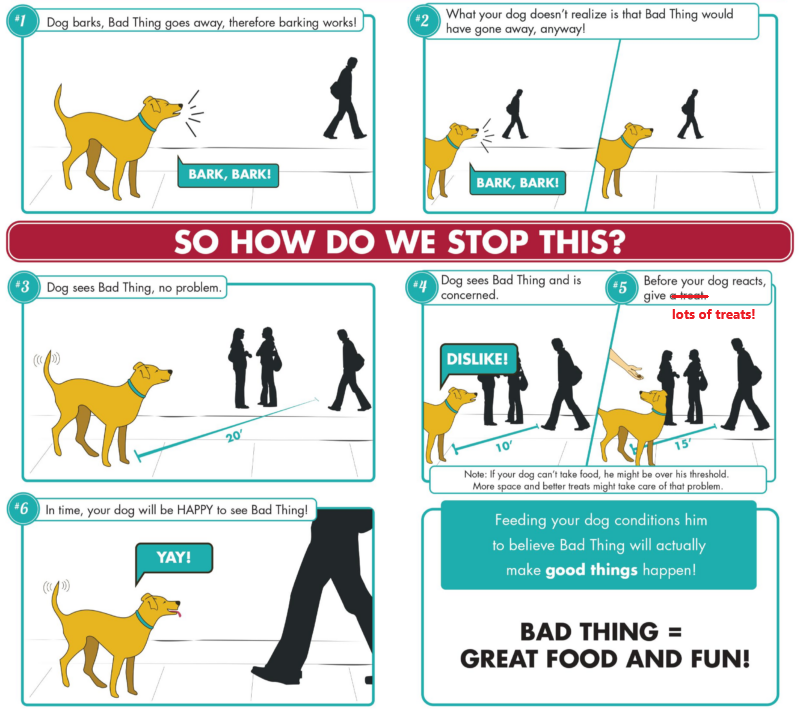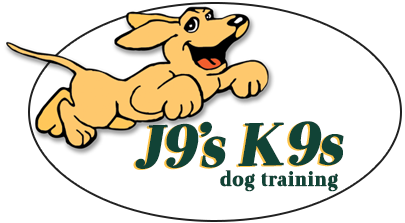Dogs can become overexcited/reactive around other dogs/people, etc. due to anxiety because these things make them nervous and they want to keep them away, or from frustration because they want to get to the dogs/people etc. Some dogs might be a bit conflicted, feeling both of these emotions at the same time and not knowing what to do with themselves.
If your dog is anxious, your goal is to show them that good things come from you when other dogs/people etc. are present with treats and/or toy play, and teach them to trust that you will not let these “triggers” into their personal space. For a frustrated dog, your goal is to make yourself the most fun thing in the world when their triggers are around, also using treats and/or toy play. Consistency is key – If the human is halfway out of treats, time to go home! Another thing to consider is what we trainers call “distance threshold”. You’ll need to work a frustrated dog at a distance that’s far enough away from their triggers for them to be able handle the situation; this will also help an anxious dog feel safer. Don’t feed your dog before you take them out because you’ll want them to be hungry, and consider bringing very high-value treats and/or toys to make interacting with you around triggers worth their while. If your dog is refusing treats (or eating them but still intensely focused on a trigger), they may be “past threshold” and you need to get them out of the situation as quickly as possible. Click here to learn about “trigger stacking”, which will be important for you to keep in mind when working with your dog.
If you have more than one dog, it’s best to walk them completely separately until they’re fully trained. And for now, it may be helpful to go on different routes for your walks, so your outings aren’t happening in areas where your dog may anticipate the appearance of triggers they’ve encountered before.
Over time and with 100% consistency, you can teach your dog a different association with the presence of other dogs/people etc.:

A great skill to train for managing your dog’s reactivity while working this protocol is something we call an “emergency u-turn.” You’ll use this behavior as a backup when a trigger you weren’t aware of suddenly appears from a blind corner, behind a bush, etc., and you don’t have time to enact your training plan. Prepare for the unexpected by teaching your dog to turn away from the surprise boogie man and run several steps at your side as you make your getaway together! Use a ton of high-value treats (or your dog’s favorite toy) and say a happy cue just before you turn like “Oops!” or “Let’s go!” Practice a LOT when there are no triggers around. You’ll want this behavior to be super-easy for both of you, so you can perform it together almost automatically when real life situations happen.
Never allow your dog to greet other dogs on walks. Here’s a link to an article about why we don’t do this, even with calm, friendly dogs: ON LEASH DOG GREETINGS. Even allowing your dog to greet a lot of other people on walks, especially if they’re excited and pulling on the leash, can create frustration when in public and lead to leash reactivity. Use the same techniques outlined above to teach your dog to focus on YOU so they won’t become “magnetized” to other humans and don’t hesitate to politely decline interactions – everyone doesn’t need to pet your dog. And of course, opt out of any contact if your dog doesn’t seem 100% comfortable.
It’s also important that your dog doesn’t rehearse reactive behavior at home, so managing their environment is crucial. Make sure they can’t see other dogs/people etc. passing by your house from inside or when they’re in your yard. For windows, you can use a film that adheres with static electricity (no adhesive needed) to block these visuals but still let in light. You can find window films in home improvement stores, but you’ll likely find a better selection online at Wallpaper for Windows (who will even pre-cut pieces to fit your windows), Decorative Films, or simply search “privacy window film” on Amazon.
Click here for an article about using window film including a video and DIY tips.
Blocking visuals isn’t necessarily a “magic” fix but it will help, and your dog won’t be rewarded by seeing other things they want to keep off their territory move away (or get even more frustrated as the other dogs/people etc. move on). If your dog barks at things passing by your house that they can’t see but can still hear/smell, redirect them to a toy or treats. You can also teach them a “positive interrupter” signal to help with this, which is a nice tool for interrupting other unwanted behaviors in your home, too.
Click here to watch a video about teaching a “positive interrupter” signal.
You can also help your dog by masking sounds they react to with “brown noise”. Click here to learn more about this.
If you’re struggling to help your dog overcome reactivity, please feel free to give us a call at 818-832-9906 and check out our Reactive Rover Classes and Events!

